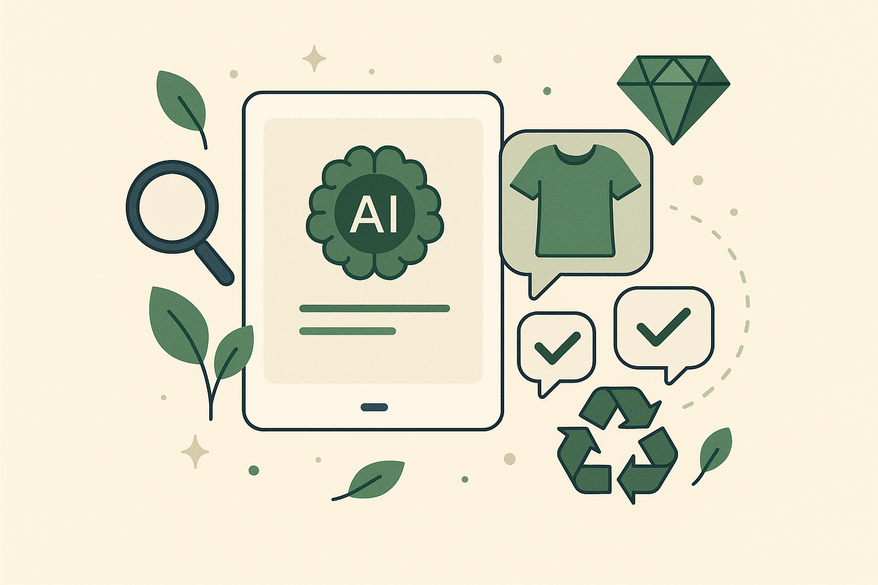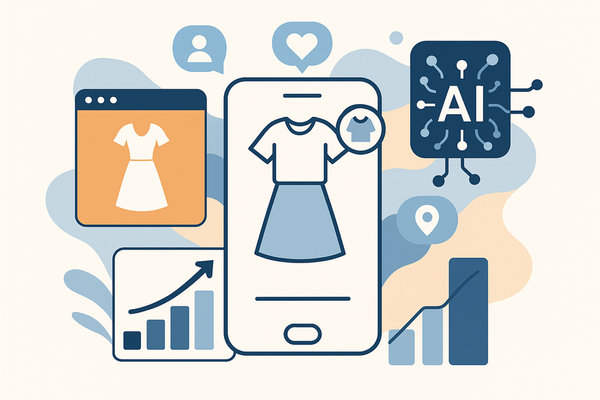Top Sustainable Fashion Recommendations AI Tools for Ethical, Eco-Friendly Style
Discover AI-powered tools for personalized sustainable fashion recommendations, empowering eco-friendly and ethical style choices.

8 min read
Key Takeaways
- Personalized sustainability: AI tailors fashion suggestions based on eco-scores, labor practices, and user ethics.
- Data-driven clarity: Advanced algorithms analyze materials, certifications, and carbon footprints to recommend green options.
- Practical tools: Barcode-scanning apps, AI marketplaces, and virtual stylists simplify eco-friendly shopping.
- Challenges to address: Data accuracy, privacy concerns, algorithm bias, and tech access barriers.
- Future outlook: Integration of blockchain, real-time carbon trackers, AR overlays, and wearable sensors for deeper transparency.
Table of Contents
- Key Takeaways
- Table of Contents
- Introduction
- Section 1: What Is Sustainable Fashion?
- Section 2: The Role of AI in Fashion Recommendations
- Section 3: How AI Helps Consumers Make Sustainable Product Choices
- Section 4: Benefits and Challenges
- Section 5: Future Trends in Sustainable Fashion Recommendations with AI
- Conclusion
- Additional Resources
- FAQ
“Sustainable fashion recommendations ai” is changing how we shop. Sustainable fashion is the movement and process of reverting the fashion industry toward ecological integrity, social justice, and responsible consumption throughout a product’s entire lifecycle. This idea covers every step—from growing fibers to making clothes to wearing and recycling them. Ethical fashion adds fair labor, eco-friendly materials, and lower environmental impact to the mix. Today, AI powers modern sustainable fashion choices by delivering personalized, data-driven recommendations based on real-world data and user values. By blending machine intelligence with eco-conscious style, AI guides you to greener purchases and supports ethical brands.
To further personalize your eco-friendly style journey, try the AI-powered Maxx Report which delivers detailed looksmaxxing insights tailored to your sustainable fashion preferences.
Section 1: What Is Sustainable Fashion?
Sustainable fashion means designing, producing, and using clothing with the planet and people in mind. It aims for a carbon-neutral and socially fair industry. Below are four core elements:
- Eco-friendly materials
- Organic natural fibers: cotton, linen, hemp grown without pesticides
- Regenerative fibers: fabrics that improve soil and biodiversity
- Recycled textiles: yarns made from post-consumer waste
- Responsible production
- Renewable energy: solar or wind power in factories
- Water conservation: closed-loop systems, rainwater harvesting
- Non-toxic dyes: plant-based or low-impact chemical dyes
- Ethical labor
- Fair wages: living income for garment workers
- Safe conditions: zero tolerance for hazards or forced labor
- Respect for rights: collective bargaining, gender equity
- Circular practices
- Repair and resale: programs that extend garment life
- Recycling schemes: take-back and remanufacture
- Upcycling: turning old pieces into new designs
Why it matters:
- The fashion industry emits 2.1 billion tons of CO₂ a year and uses vast water resources.
- Poor labor can lead to unsafe conditions, underpayment, and injustice.
- Circular methods reduce landfill waste and resource depletion.
Section 2: The Role of AI in Fashion Recommendations
AI is more than coding or robots—it’s the smart engine behind custom, green shopping tips. Here’s how it works:
Algorithms
- Machine learning models study product details (materials, certifications).
- They score items using eco-scores, fair labor markers, carbon data.
Data analysis
- Platforms ingest brand information: supplier traceability, energy use, water data.
- They match environmental ratings with user goals: low water footprint, vegan textiles.
Personalization
- Users set style tastes and ethics priorities (e.g., vegan, local production).
- AI refines suggestions in real time as you browse and rate items.
Simple flow of sustainable fashion recommendations ai:
- Data ingestion: Brands submit certifications, material lists.
- User preference capture: You choose colors, fit, and ethics.
- ML model matching: Eco-scores meet style profiles.
- Output: A ranked list of green wardrobe picks.
Experience example: A shopper wants organic cotton tees in pastel tones. The AI engine filters 10,000 products, highlights 20 from B-Corp brands, and ranks by carbon footprint. The user then picks the top three, confident they match both style and planet goals.
Section 3: How AI Helps Consumers Make Sustainable Product Choices
AI-based tools are in your pocket and on your screen. They turn complex data into simple scores. Here are three real-world categories:
- Mobile apps with label/barcode scanners
How it works:- Scan a clothing label or barcode with your phone.
- App queries a sustainability database for fiber sourcing, water use, labor ratings.
- It returns a score (e.g., 4.2/5 eco-rating) and shows greener alternatives.
- Instant on-the-go insights at stores or thrift shops.
- Compare similar items by eco-score in seconds.
- Discover small ethical brands you didn’t know.
- AI-powered online marketplaces
How it works:- E-commerce sites tag products with sustainability metadata.
- AI filters by certifications (Fair Trade, GOTS, OEKO-TEX).
- It highlights items with the highest eco and ethical marks.
- Clean, filtered shopping pages focused on green and ethical picks.
- Earn badges for “low carbon,” “vegan,” “zero waste.”
- Shop by cause (e.g., women’s empowerment, water saving).
- Virtual stylist chatbots
How it works:- Chat interface captures style goals (boho, minimalist) and ethics (plastic-free, local).
- AI suggests entire outfits or wardrobe capsules.
- It sends product links, care tips, and end-of-life recycling options.
- Personalized lookbooks that blend fashion trends and sustainability.
- Continuous style coaching via text or voice.
- Reminders for clothing care to extend garment life.
Section 4: Benefits and Challenges
Advantages of AI in Sustainable Fashion
- Greater awareness: Real-time alerts on how choices affect water, land, and labor.
- Personalized advice: Matches style, fit, and eco priorities for each user.
- Efficiency: Cuts clutter—no more endless browsing. AI-driven filters show best green picks first.
- Data-driven precision: AI leverages carbon calculators, supply chain analytics to rank items.
Potential Challenges & Limitations
- Data privacy concerns: Apps need access to buying habits, location, and preferences. Users must trust secure handling of personal data.
- Quality & accuracy: Brands may self-report sustainability data inconsistently. AI outputs can be only as good as the input data.
- Tech access barriers: Users without smartphones or stable internet can’t tap into these advanced tools.
- Algorithm bias: Models trained on limited data may overlook small or emerging ethical brands.
Balancing act: To build trust, platforms must be transparent about data use, let users opt in/out freely, and continuously audit brand claims.
Section 5: Future Trends in Sustainable Fashion Recommendations with AI
- Blockchain integration for supply chain verification
- Tamper-proof ledger tracks raw materials from farm to fabric.
- Consumers scan QR codes to view every production step.
- Real-time carbon footprint tracking
- IoT devices and AI calculate emissions for each garment you add to your cart.
- Dashboards show cumulative impact of your wardrobe.
- Augmented reality (AR) lifecycle overlays
- AR apps let you point your phone at a dress and display water usage, CO₂, and recyclability info on the screen.
- Virtual try-ons include eco-footprint badges.
- Wearable tech with maintenance sensors
- Smart labels monitor wear frequency and fabric stress.
- Apps prompt you to repair or recycle before the garment fails, extending life.
Ongoing academic research is testing these systems in pilot programs. For instance, a recent university study used blockchain to track a cotton T-shirt’s footprint from farm to store, reporting 95% data accuracy in material sourcing. As data integrity and AI models improve, these trends will make sustainable fashion recommendations ai even more robust and trustworthy.
Conclusion
By leveraging AI, consumers gain actionable, personalized insights that help reduce the environmental footprint of their wardrobes. Sustainable fashion recommendations ai empowers eco-conscious choices, supports ethical brands, and drives systemic change in how we produce and consume clothing. Try at least one AI tool or app from this guide—scan your next label or chat with a virtual stylist—to start making greener fashion decisions today.
Additional Resources
- What Is Sustainable Fashion and Why You Should Care – The VOU
- Sustainable Fashion Design: Ethics & Environmental Consciousness – The Art Career Project
- Can Ethical Fashion Truly Exist? – Greenly Earth
- Good On You app (ethical brand ratings)
FAQ
- What is sustainable fashion?
Sustainable fashion involves creating and using clothing in a way that minimizes environmental impact and ensures fair labor practices throughout the supply chain. - How does AI improve sustainable fashion choices?
AI analyzes certifications, material data, carbon footprints, and user preferences to recommend eco-friendly products tailored to individual ethics and style. - Are AI-powered sustainability tools accurate?
Accuracy depends on data quality. Reputable platforms audit brand claims and update databases frequently, but always check certifications and disclosures. - Is my privacy safe when using these apps?
Most tools request permission to collect browsing and location data. Review privacy policies, opt in/out of data sharing, and choose apps with strong security standards. - How can I get started with AI for sustainable shopping?
Download a barcode-scanning app, explore AI-powered marketplaces, or chat with a virtual stylist. Begin by scanning labels or setting eco-filters on your favorite fashion site.





